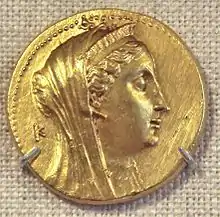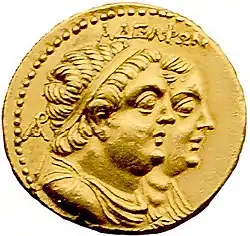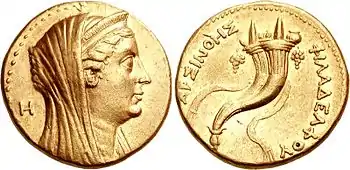Arsinoe II
Arsinoë II (Koinē Greek: Ἀρσινόη, 316 BC – unknown date between July 270 and 260 BC) was a Ptolemaic queen and co-regent of the Ptolemaic Kingdom of ancient Egypt.


Arsinoe was Pharoah Queen of Thrace, Anatolia and Macedonia by marriage to King Lysimachus and co-ruler of the Ptolemaic Kingdom with her brother-husband, Pharaoh Ptolemy II Philadelphus. Arsinoe was given the unprecedented Egyptian title "King of Upper and Lower Egypt", marking her a full pharaoh.[1]
Life
.jpg.webp)
Early life
Arsinoë was the first daughter of Pharaoh Ptolemy I Soter, founder of the Hellenistic state of Egypt, and his second wife Berenice I of Egypt.[2]
She was maybe born in Memphis, but was raised in the new city of Alexandria, where her father moved his capital.[3] Nothing is known of her childhood or education, but judging from her later life as patron of scholars and noted for her learning, she is estimated to have been given a high education.[4]Her brothers were tutored by intellectuals hired by their fathers, and it is regarded likely that she attended these lessons as well: she corresponded with the intellectual Strato of Lampsacus later in life, and he may have previously been her tutor.[5]
Queen of Lysimachus
At about age 15, Arsinoë married King Lysimachus, who was then around 60 years old.[6] Together, the pair had three sons: Ptolemy Epigonos,[7][8] Lysimachus,[8] and Philip.[8]
In order to position her sons for the throne, she had Lysimachus' first son, Agathocles, poisoned on account of treason.
Arsinoe reportedly paid for a rotunda in the Samothrace temple complex, where she was likely an initiate. [9]
Queen of Ptolemy Keraunos
In 281 BC, Lysimachus died in battle and Arsinoë fled to Cassandreia (Κασσάνδρεια). There, she married her paternal half-brother Ptolemy Keraunos. Ptolemy Keraunos was a son of Ptolemy I Soter and his first wife, Eurydice of Egypt. The marriage was for political reasons: both claimed the throne of Macedonia and Thrace (by the time of his death Lysimachus was ruler of both regions, and his power extended to southern Greece and Anatolia). Their relationship was never good.
As Ptolemy Keraunos was becoming more powerful, Arsinoë decided it was time to stop him and conspired against him with her sons. This action caused Ptolemy Keraunus to kill two of her sons, Lysimachus and Philip, while the eldest, Ptolemy, was able to escape and to flee north, to the kingdom of the Dardanians.
Arsinoë sought refuge in the Samothrace temple complex, which she had benefited during her tenure as queen.[10] She eventually left from Samothrace for Alexandria, Egypt, to seek protection from her brother, Ptolemy II Philadelphus.[11]
It is not known which year she left for Egypt. She may have left so early as 280, directly after the murder of the younger sons, or as late as 276, when the claim of her eldest son to the Macedonian throne had clearly failed after the succession of Antigonus II Gonatas.[5]
%252C_da_hermitage.jpg.webp)
Queen of Egypt
In Egypt, she is believed to have instigated the accusation and exile of her brother Ptolemy II's first wife, Arsinoe I. Whether this was actually true is unknown: it is not known which year she arrived in Egypt, and her sister-in-law may already have been exiled at that point, or her divorce may have taken place without her involvement.[12]
Whatever the case, after the divorce of Ptolemy, Arsinoe II then married her younger brother. As a result, both were given the epithet "Philadelphoi" (Koinē Greek: Φιλάδελφοι "Sibling-lovers"). The closer circumstances and reasons behind the marriage is not known.[13]
Her role as queen was unprecedented in the dynasty at the time and became a role model for later Ptolemaic queens: she acted alongside her brother in ritual and public display, became a religious and literal patron and was included in the Egyptian and Greek cults created by him for them.[14] Sharing in all of her brother's titles,[15] she apparently was quite influential, having towns dedicated to her, her own cult (as was Egyptian custom), appearing on coinage and contributing to foreign policy,[16] including Ptolemy II's victory in the First Syrian War between Egypt and the Seleucid Empire.
According to Posidippus, she won three chariot races at the Olympic Games, probably in 272 BC.[17][18]
Deification

_MET_DP121919.jpg.webp)
After her death, Ptolemy II established a cult of Arsinoe Philadelphus. She received burial and deification rites at Mendes, where she had been a priestess, which are commemorated in the Mendes stele. This stele also includes the decree of Ptolemy II announcing her cult. All temples in Egypt were required to include a cult statue of Arsinoe II alongside the main god of the sanctuary. In the relief at the top of the stele, Arsinoe is depicted among the deities receiving sacrifice from Ptolemy - an image which recurs throughout the country. Separate temples were also constructed for Arsinoe, at Memphis and elsewhere. The Fayyum region became the Arsinoite nome, with Arsinoe as its patron goddess. From 263 BC, a portion of tax on orchard and vineyard produce in each nome of Egypt was dedicated to funding the nome's cult of Arsinoe.[19]
Arsinoe's cult was also propagated in Alexandria. An annual priesthood, known as the Canephorus of Arsinoe Philadelphus, was established by 269 BC. The holder of the office was included as part of the dating formula in all official documents until the late second century BC. An annual procession was held in Arsinoe's honour, led by the Canephorus. Every household along the procession's route was required to erect a small altar of sand and sacrifice birds and lentils for Arsinoe.[20] A large temple was erected by the harbour in Alexandria. The admiral Callicrates of Samos erected another sanctuary at Cape Zephyrium, at the eastern end of the harbour, where Arsinoe was worshipped as Aphrodite Euploia (Aphrodite of the good-sailing). Similar sanctuaries were established at a number of port-cities under Ptolemaic control, including Citium in Cyprus, Delos in the Nesiotic League, and Thera. As a result of these sanctuaries, Arsinoe became closely associated with protection from shipwrecks. Coinage and statuettes depicting the divine Arsinoe survive.[19] Her divine attributes are a small ram's horn behind her ear - symbolising her connection to the ram of Mendes - and a pair of cornucopiae which she carries. She appears in this guise on a set of mass-produced faience Oenochoae, which seem to have been associated with funerary ritual in Alexandria.[21]
Arsinoe seems to have been a genuinely popular goddess throughout the Ptolemaic period, with both Greeks and Egyptians, in Egypt and beyond. 'Arsinoe' is one of the few Greek names to be naturalised as an Egyptian personal name in the period. Altars and dedicatory plaques in her honour are found throughout Egypt and the Aegean, while hundreds of her faience oenochoae have been found in the cemeteries of Alexandria.
Marriage and issue
Arsinoe married Lysimachus of Thrace in 300 or 299 BC and had three children:
| Name | Birth | Death | Notes |
|---|---|---|---|
| Ptolemy | 299/8 BC | February 240 BC | Co-regent of Egypt with her younger brother, Ptolemy II (267-259 BC), rebelled in 259 BC, subsequently Ptolemaic vassal ruler of Telmessus until 240 BC. |
| Lysimachus | 297/6 BC | 279 BC | Murdered by Ptolemy Keraunos. |
| Philip | 294 BC | 279 BC | Murdered by Ptolemy Keraunos. |
After Lysimachus' death in 281 BC, Arsinoe was briefly married to her half-brother Ptolemy Ceraunus from 280 to 279 BC and then to her full-blooded, younger brother Ptolemy II of Egypt from the late 270s BC until her death. Ptolemy II's children by his first wife Arsinoe I, including his eventual successor Ptolemy III were posthumously declared to be children of Arsinoe II in the late 260s BC.
See also
References
- Carney 2013, p. 115.
- Lorenzi 2010.
- Carney, p. 16.
- Carney 2013, p. 17.
- Carney 2013.
- Carney 2013, p. 31.
- Billows 1995, p. 110.
- Bengtson 1977, p. 569.
- Carney 2013, p. 38.
- Carney 2013, p. 60-63.
- Carney 2013, p. 66.
- Carney 2013, p. 67-70.
- Carney 2013, p. 70-82.
- Carney 2013, p. 95-100.
- Carney 2013, p. 85.
- Carney 2013, p. 90-95.
- Posidippus, p. VIII 309.
- Carney 2013, p. 142.
- Holbl 2001, pp. 101–104
- P. Oxy 27.2465.
- Thompson, D.B. (1973). Ptolemaic Oinochoai and Portraits in Faience: Aspects of the Ruler-Cult. Oxford: Clarendon Press.
Bibliography
- Carney, Elizabeth Donnelly (2013). Arsinoe of Egypt and Macedon: A Royal Life. Oxford University Press. ISBN 978-0-19-971101-7.
- Lorenzi, Rossella (December 2, 2010). "Did female Egyptian pharaoh rule before Cleopatra?". NBC News. Retrieved 2010-12-05.
- Billows, R.A. (1995). Kings and colonists: aspects of Macedonian imperialism. Brill.
- Bengtson, H. (1977). Griechische Geschichte von den Anfängen bis in die römische Kaiserzeit. C.H.Beck.
- Posidippus. Milan Papyrus aka P. Mil. Vogl.
Further reading
- S.M. Burstein, "Arsinoe II Philadelphos: A Revisionist View", in W.L. Adams and E.N. Borza (eds), Philip II, Alexander the Great and the Macedonian Heritage (Washington, 1982), 197-212
- P. McKechnie and P. Guillaume (eds) Ptolemy II Philadelphus and his World. Leiden, 2008.
- M. Nilsson, The Crown of Arsinoë II: The Creation of an Image of Authority. Oxford, 2012.
- D. L. Selden, Daniel L. "Alibis". Classical Antiquity 17 (2), October 1998.
External links
| Wikimedia Commons has media related to Arsinoe II. |
- Coin with her portrait
- Encyclopædia Britannica
- Arsinoe II entry in historical sourcebook by Mahlon H. Smith
_Pentathlon.svg.png.webp)